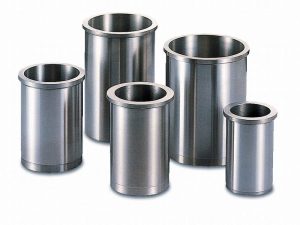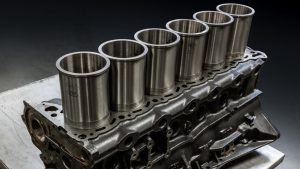Cylinder liners are fundamental components in the construction and operation of an internal combustion engine. Although often overlooked, these sleeves play a crucial role in engine durability, efficiency, and performance. Understanding what cylinder liners are, their types, functions, and how to maintain them properly can help vehicle owners and mechanics optimize engine life and reliability.
What Are Cylinder Liners?

A cylinder liner, also called a cylinder sleeve, is a cylindrical metal insert fitted into the engine block’s cylinder bore. Its primary purpose is to provide a hard, wear-resistant surface on which the piston rings move as the piston reciprocates during engine operation.
The liner separates the piston and piston rings from the softer engine block material, typically cast iron or aluminum, protecting the block from direct wear caused by friction and high combustion pressures.
Why Use Cylinder Liners?
-
Wear Resistance: Liners are made from specially treated materials designed to resist wear from constant piston movement.
-
Heat Dissipation: They help in dissipating heat from combustion to the cooling system efficiently.
-
Engine Repair and Maintenance: When the cylinder bore wears out, replacing the liner is easier and more cost-effective than replacing the entire engine block.
-
Corrosion Resistance: Liners protect the block from corrosion caused by coolant and combustion gases.
Types of Cylinder Liners
Cylinder liners come in several types, each suited to different engine designs and applications:
| Type | Description | Typical Use Cases |
|---|---|---|
| Wet Cylinder Liners | Directly exposed to coolant; sealed with gaskets at top and bottom | Heavy-duty engines, large diesel engines |
| Dry Cylinder Liners | Not in direct contact with coolant; tightly pressed into the block bore | Passenger cars, light commercial vehicles |
| Cast-in Liners | Permanently cast or shrunk into the block; cannot be removed | Some high-performance or older engines |
| Replaceable Liners | Designed to be removed and replaced during overhaul or repair | Diesel engines, trucks, industrial engines |
Wet vs. Dry Liners: Key Differences
| Feature | Wet Liners | Dry Liners |
|---|---|---|
| Contact with Coolant | Direct contact | No direct contact |
| Cooling Efficiency | Higher due to direct coolant flow | Lower; depends on block design |
| Replacement Ease | Easier to remove and replace | More difficult; require precise fitting |
| Engine Block Design Impact | Allows lighter blocks | Requires a stronger block for heat transfer |
Functions of Cylinder Liners
-
Provide a Durable Surface for Pistons: Liners resist abrasion and mechanical wear caused by the piston rings rubbing against the cylinder walls.
-
Seal the Combustion Chamber: Ensures minimal leakage of combustion gases past the piston rings.
-
Assist Heat Transfer: Transfers heat from combustion to the engine cooling system, preventing overheating.
-
Support Structural Integrity: Maintain cylinder bore roundness and stability under high pressure.
-
Facilitate Engine Repair: Enable replacement of worn or damaged liners instead of the entire engine block.
Common Materials Used for Cylinder Liners
| Material | Properties | Application |
|---|---|---|
| Cast Iron | High wear resistance, good heat conduction | Most common liner material |
| Steel Alloy | Higher strength and toughness | Heavy-duty and performance engines |
| Composite Materials | Combines metals with ceramics or coatings | Advanced engines requiring durability |
| Aluminum (with coating) | Lightweight, requires special coatings | High-performance and lightweight engines |
How to Maintain Cylinder Liners
Proper maintenance of cylinder liners ensures prolonged engine life and optimal performance. Here are some essential tips:
Maintenance Checklist
-
Regular Oil Changes: Use recommended engine oil to reduce wear and corrosion inside the cylinder.
-
Coolant System Maintenance: Prevent coolant leaks and maintain correct coolant levels to avoid overheating and corrosion of wet liners.
-
Monitor Engine Temperature: Overheating can cause liner distortion or cracking.
-
Inspect for Wear and Scoring: During engine overhauls, check for visible signs of scoring, pitting, or ovality.
-
Use Quality Fuel: Poor fuel quality can cause deposits and corrosion inside the cylinder.
-
Maintain Air Filtration System: Prevent abrasive particles from entering the combustion chamber.
-
Avoid Prolonged Engine Idling: Reduces liner cooling and increases risk of liner wear.
-
Follow Manufacturer’s Service Schedule: Adhere to recommended inspection intervals.
Signs of Cylinder Liner Problems
| Symptom | Possible Cause |
|---|---|
| Excessive Oil Consumption | Worn or damaged liner surface |
| Loss of Compression | Cylinder bore out of round or scored |
| Overheating Engine | Coolant leakage or liner distortion |
| White Smoke from Exhaust | Coolant leaking into combustion chamber |
| Unusual Engine Noise | Piston slap due to liner wear or looseness |
Cylinder Liner Replacement and Repair

Replacing worn cylinder liners can restore engine performance and extend service life. Replacement involves removing the old liner and fitting a new one, often requiring precision machining to ensure proper fit and sealing.
Some liners can be honed or re-bored to restore surface finish, while others require full replacement. Proper sealing with gaskets and ensuring correct cooling passages are vital to avoid future issues.
Summary Table: Cylinder Liner Types, Uses, and Benefits
| Type | Benefits | Drawbacks | Typical Use |
|---|---|---|---|
| Wet Liners | Superior cooling, easy replacement | More complex sealing required | Heavy-duty diesel engines |
| Dry Liners | Simpler engine design, durable | Less efficient cooling | Passenger vehicles |
| Cast-in Liners | Strong, integral to block structure | Difficult to repair or replace | Performance engines |
| Replaceable Liners | Cost-effective maintenance and repair | Requires skilled installation | Industrial engines |
Where to Buy Quality Cylinder Liners
When replacing cylinder liners, choosing high-quality parts is crucial to ensure durability, proper fit, and engine reliability. To find a reliable supplier, consider:
-
Verified quality standards and certifications
-
Wide selection for different engine makes and models
-
Competitive pricing and warranty options
-
Customer support and technical assistance
Buy Cylinder Liners online from trusted suppliers for guaranteed performance and compatibility. Visit Buy Cylinder Liners online to explore quality options for your vehicle or machinery.
Final Thoughts
Cylinder liners are an essential part of the engine block, providing durability, heat management, and repairability. Understanding their types, functions, and maintenance needs helps prevent premature engine wear and costly repairs. Regular inspection and timely replacement of worn liners will keep your engine running smoothly for years.